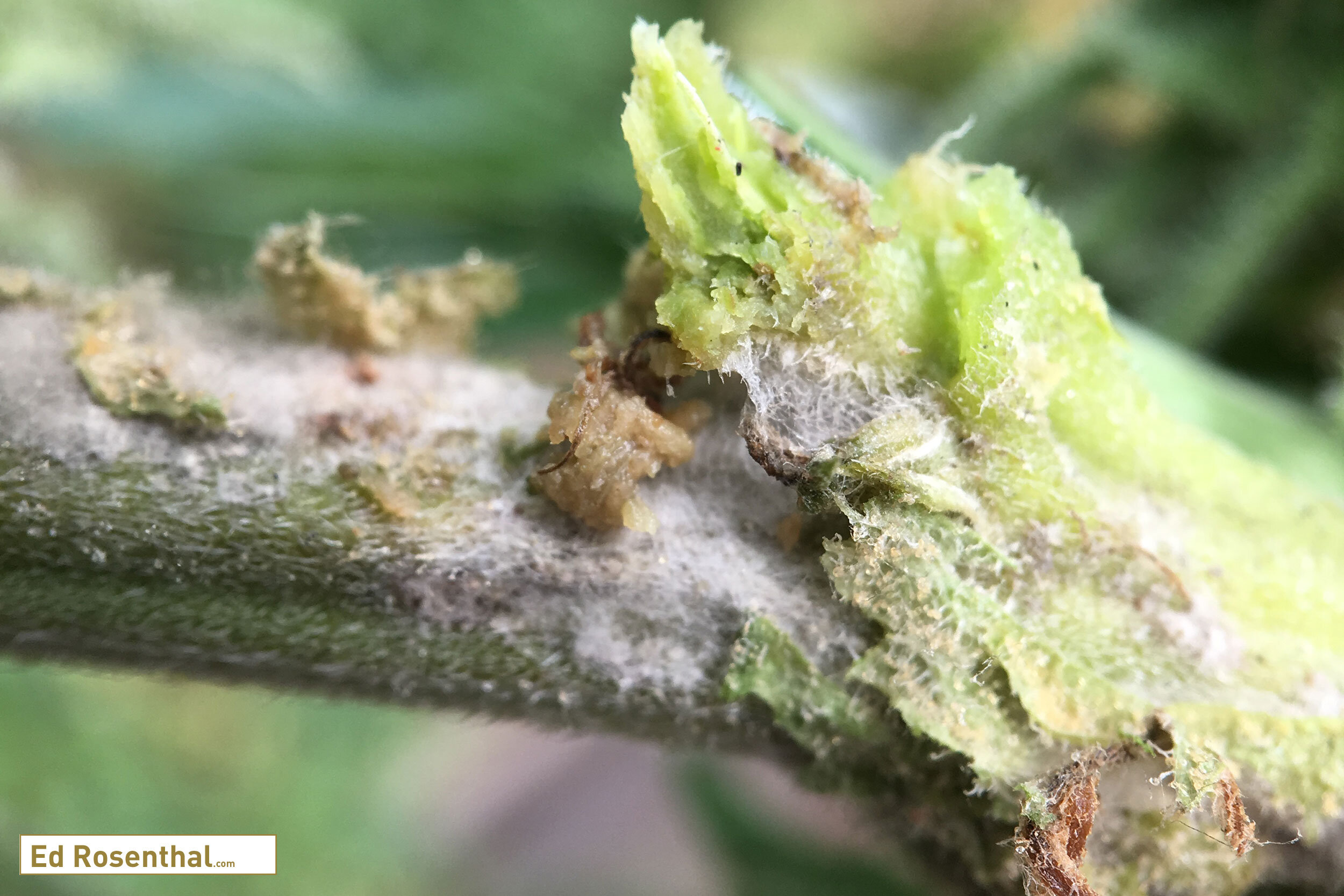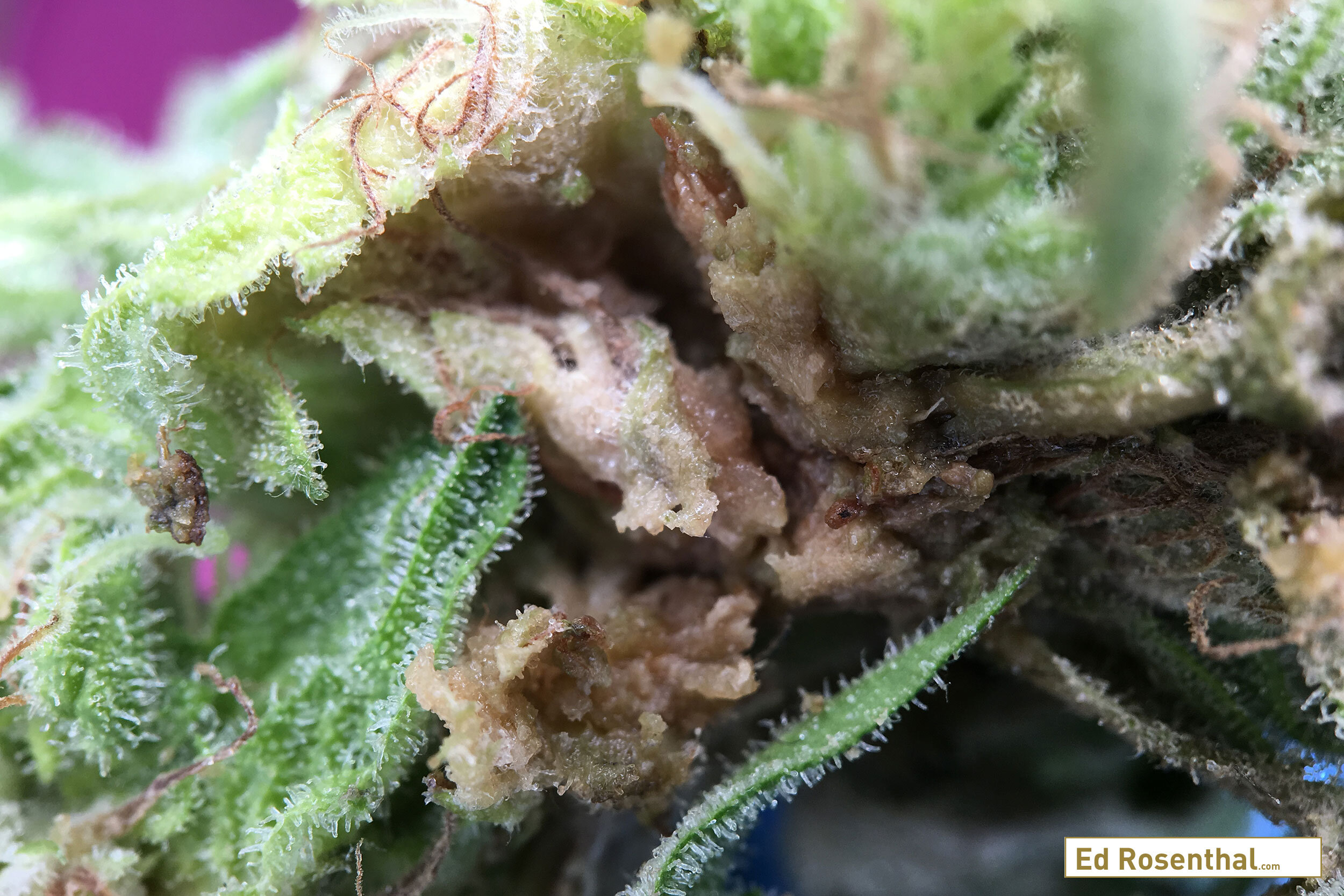The dangers of microbial contaminants in cannabis and how to prevent mold and mildew
Powdery mildew on cannabis leaves.
By Reginald Gaudino VP R&D at Front Range Biosciences.
Molds, bacteria and yeast are present everywhere, including in the air we breathe
Unless cannabis is grown in a clean room with appropriate air filtration and other good growing and laboratory practices, it is inevitable that these microorganisms will be found on cannabis flowers and products made with them.
Most microorganisms do not present a problem at low levels, though some pathogenic microorganisms are harmful even at low levels because they produce toxins that cause a variety of symptoms: from allergy-like symptoms to various types of cancer.
Other microorganisms are harmful at mid to higher levels of contamination, particularly if they are inhaled.
Immunocompromised patients including those receiving chemotherapy are at a higher level of risk to all microorganisms, where even low levels of microbial contamination can lead to fatality. Contaminated medical cannabis and incidence of diseases such as Aspergillus nodulosis (a disease caused by the inhalation of Aspergillus niger) has already been noted (1).
Recent test shows randomly selected samples of cannabis all had detectable levels of microbial contamination
Rain Effect: Brown mold.
Recently, Steep Hill Labs collaborated with medical researchers at University of California, Davis - Medical Center, and found that of 20 randomly selected samples submitted for testing at the Steep Hill Facility in Berkeley, California all had detectable levels of microbial contamination, and many had significant pathogenic microorganism contamination (2). The variety of potentially harmful bacteria and fungi found was surprising and included:
Klebsiella, Pseudomonads (several, including P. aeroginosa)
Enterobacteria (including both pathogenic and non-pathogenic forms of E. coli)
Acinetobacter (several, including baumannii)
Aspergillus (in-cluding niger)
Mucor
Penicillium
Botryotini
And many other bacteria and fungi
Some of the samples studied harbored multiple potentially pathogenic microorganisms (e.g., Aspergillus, Fusarium, Penicillium, Enterobacter, Pseudomonas)
Sterilization of the cannabis product does not necessarily ensure the product is completely safe for consumption
Moldy cannabis stem.
Because the presence of microbial contaminants often results in the by-products of growth being left behind, sterilization of the product does not necessarily ensure the product is completely safe for consumption. Sterilization of the contaminated substance may kill live microbes, but it does not remove the presence of the microbes (DNA, proteins, and/or lip-ids left behind), or remove the toxins certain microbes leave behind.
The DNA, lipids and proteins from microbial contaminants, whether pathogenic or nonpathogenic, also have the potential of acting as antigenic determinants on their own, and could lead to a full range of allergy like reactions. If the cannabis contaminated with pesticides, mycotoxins or endotoxins is destined for extraction and concentration, there is a significant risk that the contaminants, particularly pesticides will be concentrated and become a greater problem for the end user.
Pharmaceutical grade medical cannabis can be produced using good growing practices (GGP)
Brown mold on cannabis bud.
This requires clean grow rooms/green houses, complete humidity and ventilation control, HEPA filtered air systems and gowned workers wearing hair covering; essentially the same practices used to produce pharmaceutical products. Without this infrastructure, it is impossible to avoid microbial contamination, which leads to pesticide usage.
Pesticides add another level of risk to the cannabis end user. Thresholds targeted in those states that even require pesticide testing are based on information from studies done on skin contact or ingestion. None of the research conducted studied pesticide inhalation. So the levels being considered aren’t relevant to potential harm or risk mediation for the in-tended use. It is likely that many of the pesticides used will have very different effects, and at much lower levels, due to the introduction through the lungs while smoking.
It has already been well publicized that Myclobutanil, the primary ingredient used to control fungal infestations (particularly powdery mildew), turns to Cyanide gas.
Further investigation into the effect of all pesticides used on cannabis is needed, as are experiments to identify the types, if any, of microbial contaminants that pass through the smoke stream. Investment in these Standard Operating Procedures will enable the production of more consistent cannabis product between batches, assuming identical or nearly identical genetics are used each growing cycle.
Mold on cannabis bud.
To ensure the safety of any cannabis flower product, but particularly medical Cannabis, grown under any conditions, DNA based microbial testing methods (e.g., PathogenDx, qPCR, DNA microbiome sequencing) must provide the necessary scientific rigor to ensure compliance with pharmaceutical standards.
Detection of DNA indicates that a particular species was resident on the plant at some point, absence indicates the complete lack of colonization of the flower by whichever species. Detection of a species known to produce toxins should require testing for that toxin. Absence of the toxin, and presence of the microbe below levels established for specific patient groups, would allow certification of the product for use by some patients and adult users. If toxin residue or pesticides or serious microbial contamination is detected, that product could be evaluated for remediation (e.g., chemical extraction and fractionation to produce extracts free of the contaminant).
How to prevent mold on your cannabis
Mold in the cannabis stem.
Buds infected with powdery mildew or other molds and fungi are unfit for smoking. Many jurisdictions mandate laboratory testing of commercial cannabis for fungal and bacterial pathogens.
Moldy buds are not suitable for use in extracts either. Concentrating contaminated cannabis using ice water transfers toxins and spores into the final extract, making it unfit for smoking. Moist hash molds when stored at room temperature.
Butane and carbon dioxide extractions kill mold and mildew but leave toxins behind. As a result, professional extractors in legal states are facing mandatory lab testing.
The best way to deal with infection is prevention
Mildew on cannabis leaves.
Botrytis (gray or brown mold) is found almost everywhere and infects many plants, including marijuana. The fungus, which germinates only on wet plant tissue when the temperature is between 55-70° F (13-21° C), consumes the plant. It can attack both live and drying buds.
Mold grows when buds are grown or dried in an environment that is too humid or when incompletely dried buds are sealed in air tight containers.
Once mold starts growing, it tolerates a wider range of humidity and temperatures. After mold depletes the oxygen in a sealed container, anaerobic bacteria become active, turning the buds brown and crumbly.
A sure sign of anaerobic bacterial activity is an acrid ammonia odor.
When buds are dried and cured properly, they rarely become infected with mold. The best way to deal with infection is prevention.
Mildew on cannabis leaf.
Wet marijuana is 80% water. Molds colonize plant matter which contains as little as 15% water, so it’s important to dry quickly, and in as controlled a fashion as possible without sacrificing terpenes.
This is done by keeping humidity under 50% and not raising the temperature above the low 70’s. With low humidity, the air is not saturated and absorbs moisture faster.
Mold and fungal spores are mobile; they are in the air and on surfaces. They require a temperature of 60-75° F (15.5-24° C), high humidity and an acidic environment to germinate. When humidity is kept below 50% and the leaf surface alkaline, mold spores are prevented from germinating.
When the cannabis plant is alive, it has natural defenses that fight off constant attacks by pathogens. As soon as the plant is harvested, it is subject to attack by botrytis, aspergillus and penicillium.
Aspergillus is a common mold that thrives in oxygen-rich plant environments. It causes sinus and lung infections in people with compromised immune systems and has been implicated in some of the few recorded deaths related to marijuana.
Smoking marijuana is safe, but inhaling mold spores isn’t.
1. Fatal aspergillosis associated with smoking contaminated marijuana, in a marrow transplant recipient: R Hamadeh, et al. Chest. 1988;94(2):432-433. doi:10.1378/chest.94.2.432, Salmonel-losis Associated with Marijuana—A Multistate Outbreak Traced by Plasmid Fingerprinting D.N. Taylor, M.D., et al. N Engl J Med 1982; 306:1249-1253, Aspergillus: An Inhalable Contaminant of Marihuana N Engl J Med 1981; 304:483-484
2. Thompson et al, “A Microbiome Assessment of Medical Marijuana”, Clinical Microbiology and Infection (2017), doi: 10.1016/j.cmi.2016.12.001
Join our cannabis community
Follow Us













